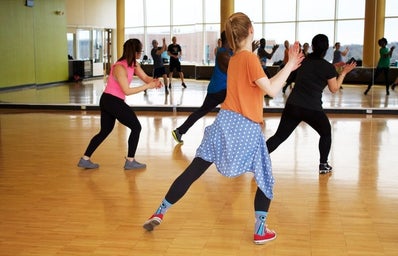As someone who has no prior dance experience apart from a couple high school musicals, I never was super interested in learning dances before I started getting into K-pop. All the dances I saw my peers do never looked like they were much fun, especially once TikTok started gaining traction (sorry if you’re a TikTok fan!).
Once I started listening to K-pop and realized that I do in fact need to find a more fun way to work out to give myself much-needed exercise, everything seemed to fit right into place.
Right now, my repertoire includes (in order): “What Is Love?” by TWICE, “Heart Attack” by LOONA’s Chuu, “Cupid” by Oh My Girl, “Up” by IZ*ONE, the chorus of “ASAP” by STAYC, the chorus of “Dynamite” by BTS, the chorus of “Peekaboo” by Red Velvet and an abridged version of “In the morning” by ITZY.
But it’s not as easy as watching a performance video once or twice; no, learning any dance takes time and patience. So here I have for you some tips from someone who has learned K-pop dances by several different means. A lot of these can be applied to learning other dances, but I have not, so I focused mostly on K-pop. I suggest trying these few ways to see what works best for you, since everyone learns differently!
Learning from Someone Else (“In the morning,” “Peekaboo,” “ASAP,” “Dynamite”)
As you can see from the title of this section, one of the first ways you can learn is the same way as learning any other choreography! Usually learning from someone else as a stand-in choreographer as sorts will be used for performances, especially group performances. A video will sometimes be used in conjunction, but this isn’t always the case.
Learning from someone else is often helpful when positions are needed, again usually when a group performance is going to happen, or during a dance workshop of some sort. A workshop was where I learned the choruses of “ASAP” and “Dynamite,” with the teachers being on a stage so the rest of us could see.
This kind depends on the person or people who are teaching the song and how well they know it. It also depends on that person in terms of whether or not they learned from the official choreography or from a dance tutorial.
Pros:
- You get individualized instruction from an actual person
- More often than not, you’re working with more than one person, which can help in learning the moves and positions
- Depending on the dance and how many members there are, you’ll be able to choose a member to follow and stick to them
- You’ll have auditory instruction on what you’re doing
Cons:
- If you’re working with other people, you might not be learning at the speed you want
- Depending on the dance and how many members there are, you may not learn the exact moves for sake of simplicity within the group
- There may not be a mirror available, so you and the choreographer will both need to move around a lot to make sure the moves are correct
Learning from a Video: Dance Tutorial
Dance tutorials are often filmed specifically to teach specific dances, often with the use of a mirror. I haven’t used one of these myself, since I often prefer to use the two methods listed below.
A lot of the people who film these kinds of dance tutorials are dancers or have been making these videos for a long time and will upload them alongside dance covers. I’ll recommend Lisa Rhee here; I’m always astounded by how quickly she uploads her covers and tutorials, sometimes in the same day the song was released!
Dance tutorials can either follow a specific member (in which case the dancer will specify either in the video or the video description) or follow a combined path of the center members. In that case, you’ll be learning, essentially, more choreography, and possibly more complicated choreography.
Pros:
- The moves are taught slower before being shown at full-speed
- The different sections of the song are often broken up to learn more easily
- You can adjust the speed of the video
- There’s sometimes audio instruction on what you’re doing, helpful for auditory learners
Cons:
- Dance tutorials often combine the center members, so it’s not the exact choreography one member follows
- The video often follows a different sort of format, which means you’ll be getting up to rewind the video more often
- The stop-and-start of the video can be a hassle if you prefer to learn in a continuous fashion
Learning from a Video: Dance Cover (“What is Love?” “Up”)
Dance covers can be done either in group or individual settings. I tend to use individual, since the group covers aren’t mirrored (though they look amazing). I definitely recommend checking to see if the covers are mirrored, or else you’ll be learning the dance moves opposite how the actual group performs it. This is why a lot of dance tutorials (above) tend to use mirrors to teach. This channel has a good amount of dance covers.
Sometimes, because of the way dances are structured, the fact that you’re following the centers in individual covers means that you don’t really get a break to move to another position or have less complicated or detailed choreography like the members do. A good way to see this played out is IZ*ONE’s “Up” live stage versus the dance cover I use. That dance cover has to be the hardest dance I’ve ever learned, bar none.
Pros:
- These are zoomed in more, so it’s easier to see the details of the moves
- Like all videos, you can slow it down or speed it up as needed
- If you prefer to learn choreography smoothly, continuous videos like this are perfect
- If it follows center choreography, you’re essentially learning more and getting a better workout than following just one member
Cons:
- You won’t be learning a particular member’s exact part, unless you happen to find a mirrored group cover with the same number of members as the original group
- Different covers of the same song might look different
- There could be differences in overall video or audio quality
- There’s no auditory explanation of what you’re learning
Learning from a Video: Mirrored Performance/Practice (“Heart Attack,” “Cupid”)
I tend to use this method a lot. I have another six or so dances in my playlist to learn, though I haven’t started yet. This is what I find the most faithful way to learn a dance via video, since you’re following the members themselves. It was easiest for a song like “Heart Attack” since it’s Chuu’s solo song, though the video quality wasn’t as good as “Cupid” since that was a fancam (video filmed by an audience member).
Pros:
- You’ll be able to follow a particular member through the whole song
- If it’s a dance practice, it can sometimes be easier to see what the members are doing in their practice clothes instead of their performance outfits
- If it’s a dance practice, the camerawork is guaranteed to be steadier than most live stages or fancams
- Like all videos, you’ll be able to slow it down or speed it up as needed
- The choreography stays the same in each video (unless a member is missing or left the group, in which case the choreography might be rearranged to compensate. I definitely did not find this out the hard way)
Cons:
- The quality of these videos can be less than stellar, especially if it’s a mirrored fancam of a live stage
- There’s no auditory explanation of what you’re learning
- Sometimes the videos of official dance practices will be zoomed out, so you can’t see as much detail
- It can be hard to find mirrors of some practices or good quality mirrored performances
And that’s that! The next songs on my list are “Dun Dun Dance” by Oh My Girl, “Pirate” by EVERGLOW, “Love So Sweet” by Cherry Bullet, “Bungee (Fall in Love)” by Oh My Girl and “Shine” by Girls Planet 999/Kep1er. Wish me luck and I’ll see you in my next article!


